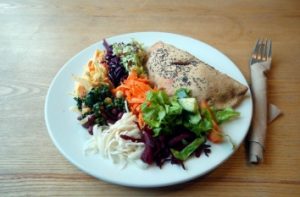Being Savvy About Portion Sizes Isn’t Enough To Curb Overeating, Study Finds
 By now, most of us know that portion sizes in restaurants are too big – at least by general standards of what is considered a healthy serving.
By now, most of us know that portion sizes in restaurants are too big – at least by general standards of what is considered a healthy serving.
But despite the knowledge that a fish serving should be the size of your palm or that a fist full of almonds is a sensible amount, new research shows that when too much food is put in front you, you’re probably going to eat more.
Sound simple enough? Maybe. However, researchers from the University of New South Wales say that bigger portion sizes can lead to consuming about 87 extra calories a day. And for those struggling with eating disorders or on the road to recovery, it poses an even more serious problem, especially when eating out at restaurants.
Women eat more despite educational interventions
As reported in the Journal of Health Psychology, a study assessed the eating habits of 96 women to determine how effective education is when it comes to overeating. Participants were served portions sizes of either 300 or 600 grams of macaroni pasta with tomato sauce for lunch.
Women in one group were given a brochure about how external factors like advertising, portion size, mood and social influences can contribute to overeating. The other women were taught simple mindfulness exercises, like focusing on the flavor and taste of the food and paying attention to feelings of hunger before eating.
“Neither of these brief exercises reduced the effects of portion size,” Dr. Lenny Vartanian, a senior lecturer in the UNSW School of Psychology and an author of the paper, said in a statement. “Overall, participants in the larger portion group consumed about a third more pasta – 69 grams – than those in the smaller portion group.”
Portion sizes growing
The study also explains how portion sizes have steadily grown since the 1970s, and they have been linked in some research to rising obesity rates.
“If no effective approaches are found, it may be necessary to develop policy-related changes to provide a healthier food environment for people,” Vartanian said.
Source: Science Daily
 Eating Disorder Self Test. Take the EAT-26 self test to see if you might have eating disorder symptoms that might require professional evaluation. All answers are confidential.
Eating Disorder Self Test. Take the EAT-26 self test to see if you might have eating disorder symptoms that might require professional evaluation. All answers are confidential.